In this six minute read:
- How much money do bowling alleys make on a typical day?
- Which days of the week are biggest for bowling alleys?
- The busy (and slow) seasons for bowling alleys
- The biggest days of the year for bowling alleys (and what about National Bowling Day?)
- How to make the most out of busy (or slow) seasons if you own or manage a bowling alley
With National Bowling Day coming up on August 10, 2019 (it’s always the second Saturday in August), it got us wondering about local bowling alleys across the country. How much do bowling alleys make on a normal day? When do Americans most love to hit the lanes? Does National Bowling Day move the needle? What about other holidays?
We analyzed credit card transaction data at local bowling alleys from across the country to answer these questions and more.
How much do bowling alleys make on an average day throughout the year?
The first thing we did was take a look at what the average given day looks like at local bowling alleys across the country. To do this we looked at the average number of transactions a bowling alley processed throughout the year, what the average ticket price was per transaction, and how much revenue each bowling alley brought in. Here’s what we found:
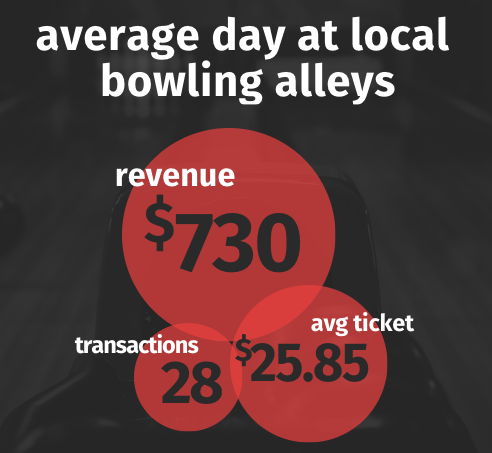
On any given day throughout the year, the average bowling alley in our study brought in about $730 in revenue. They processed around 28 transactions at $25.85 per ticket. Of course, not all bowling alleys are created equal.
The busiest alleys in our study processed over 100 transactions on average per day, while some of the slower bowling alleys processed only a a handful of transactions. Average ticket was much more consistent, although some pricier bowling alleys saw average ticket prices upwards of $100 per transaction.
What are the biggest days of the week for bowling alleys?
The numbers above give a good look at the average overall day, but let’s take a look at the average week to see how things differ from day-to-day.

As you’d probably expect, weekends are huge for bowling alleys across the country. Well over half (66%) of all revenue at bowling alleys comes in on Fridays, Saturdays, and Sundays.
As you can see, this is entirely the result of a huge increase in foot traffic, as average transactions go way up during the weekends. On Saturdays, the biggest day of the week by far, the bowling alleys processes an average of 52 transactions—a whopping 121% increase over the average number of transactions during all other days of the week.
Average ticket, on the other hand, remains much more consistent throughout the week. Bowlers spend $27.19 per ticket on Saturdays, which isn’t much more than the $24.32 per-ticket average on Tuesdays (the lowest of the week).
This suggests bowling alleys are more dependent on driving more customers in their doors as opposed to trying to get customers to spend more money.
What time of year do bowling alleys make the most money?
It’s clear that weekends—and particularly Saturdays—are massive for bowling alleys, but what about certain weeks and months of the year? Are there “busy seasons” for bowling alleys? Or do Americans like to hit the lanes regardless of the time of year?
We answered this question by looking at the total dollars spent at bowling alleys each week throughout the year.
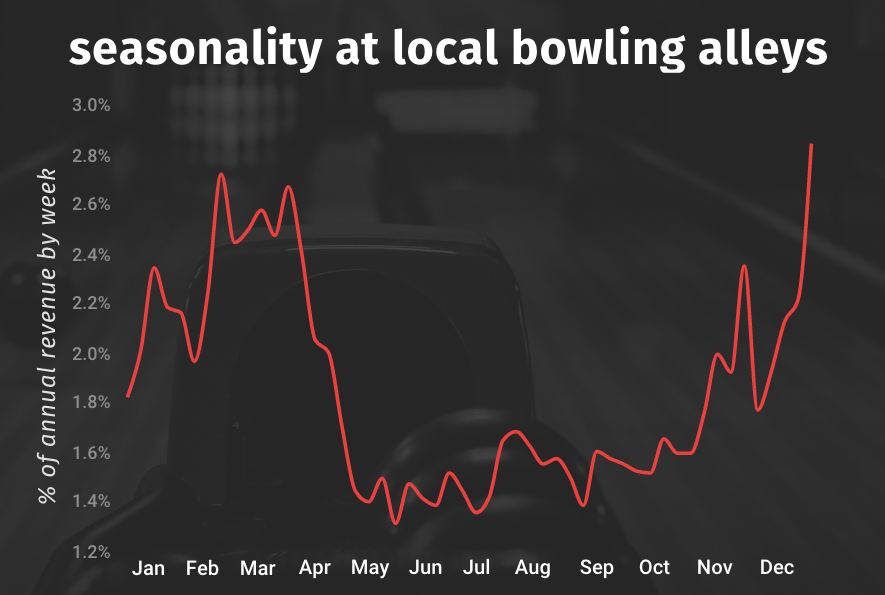
As you can see, when it’s cold and dark outside, Americans are far more likely to head to their local bowling lanes for their fun weekend activity. The year starts out strong in mid-January, and particularly through February and March. But as the days grow longer and warmer, and choices in recreation more plentiful, sales drop in kind.
Things pick up again in November, spike during the Thanksgiving break, and then skyrocket during the final week of the year.
What are the biggest days of the year for bowling alleys?
The first few months of the year are clearly huge for bowling alleys, but we wanted to see which days of the year were the biggest. But before we get into the single-biggest days of the year, as the chart above suggests, we need to take a special look at the week after Christmas.
The week after Christmas is the biggest week of the year for bowling alleys
During the lull after the hectic holiday season and the return to the 9-to-5, Americans appear take advantage of their downtime by hitting the lanes with family and friends. Here’s a day-by-day revenue comparison of the week after Christmas vs the day-of-week average at bowling alleys across the country.
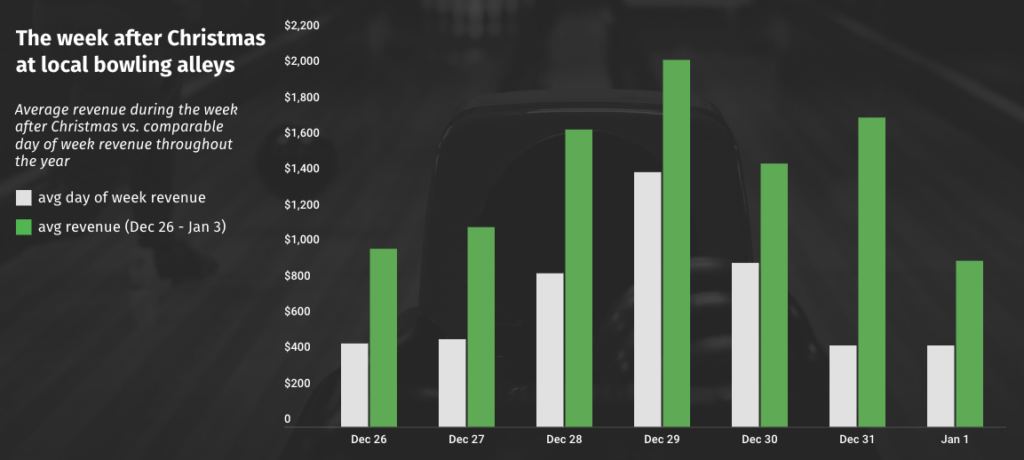
As you can see, every single day during that stretch sees bowling alleys bring in far more revenue than they would on similar days of the week. You can rest assured that anyone who gets a personalized bowling ball for Christmas doesn’t wait to test it out!
The top five days of the year for bowling alleys: Saturdays during Spring Break outperform any major holiday
The week after Christmas was responsible for the #1 Monday, #1 Wednesday, #1 Thursday, and #1 Friday of the year—but as we showed earlier, Saturdays are king at the bowling lanes. And sure enough, the top 5 days of the year were all on Saturdays.
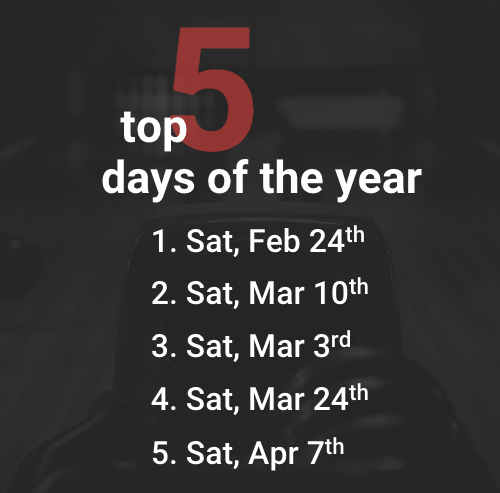
As you can see, the top days for bowling alleys are all inconspicuous Saturdays from February through early April. This suggests that, unlike many other types of businesses, bowling alleys don’t really rely on major holidays to drive big business.
Instead, they benefit most from the times of year when people have a little more time off and more downtime (Spring Break, post-Christmas break, etc.) than big single-day holidays or long weekends (Labor Day, Memorial Day, etc.)
Do bowling alleys make more money during PBA tour majors?
Big time bowling fans might also recognize the #1 day of the year also fell during the weekend of the PBA Players Championship—one of the Professional Bowlers Association’s major tournaments. This made us wonder whether weekend revenue during the four PBA Majors of the year was larger than typical weekends.
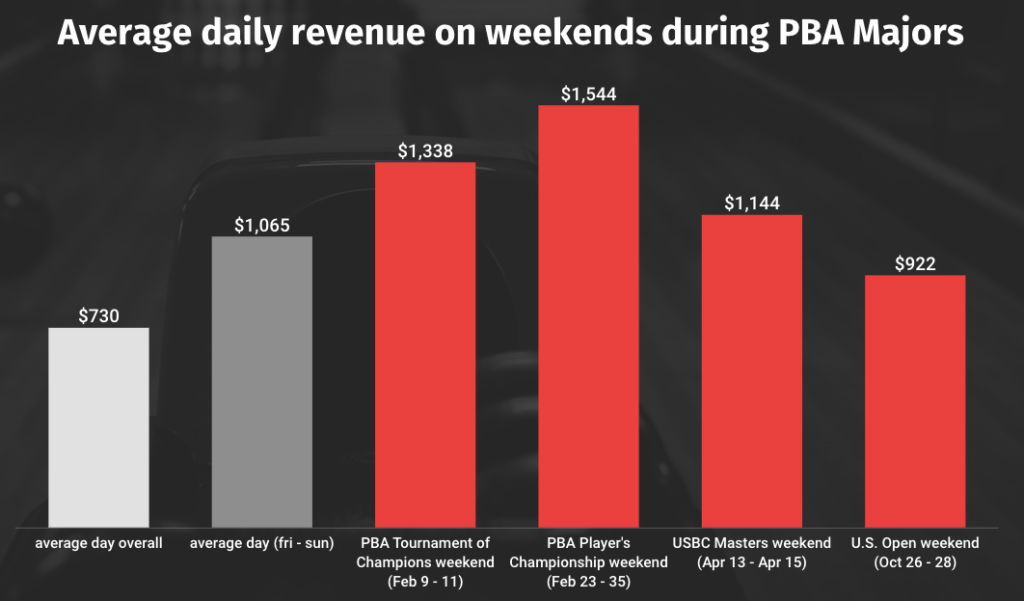
As you can see, with the exception of the US Open, average revenue on weekends during PBA majors was indeed larger than a typical weekend. Of course, this might be mostly due to the tournaments taking place during the busy season for bowling alleys. But you might be safe to assume plenty of bowling fans watch the sport’s biggest tournaments while knocking down pins of their own.
Do bowling alleys do a lot of business on National Bowling Day?
Since it motivated us to write this article in the first place, we had to finish by taking a look at National Bowling Day. Is it enough to get more people to line up for a pair of bowling shoes and an evening at the lanes?
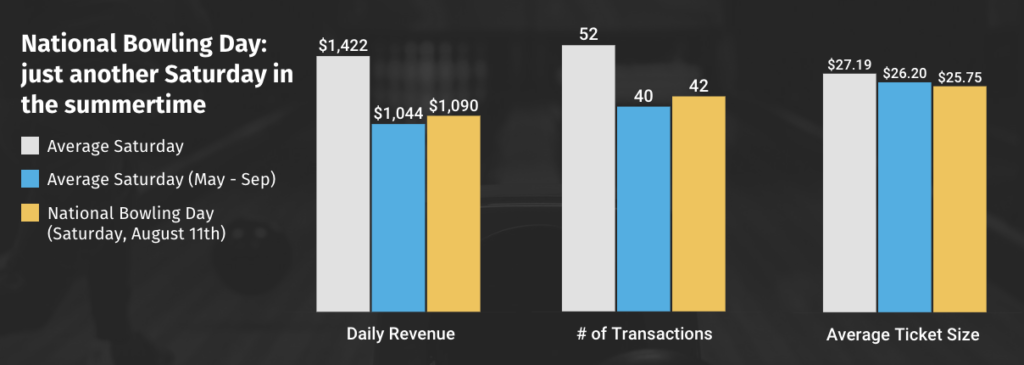
As you saw in the seasonality chart earlier, summer is the slowest time of the year for bowling alleys. And while Saturdays in the summer bring in more revenue than the average day throughout the year, they’re far slower than the average annual Saturday. And National Bowling Day, which always falls on the second Saturday in August, looks just like the typical Saturday during the summer.
If you own or manage a bowling alley: here’s how to get the most out of the busy season, and get more customers when things slow down
Do you own or manage a bowling alley? If so, do you experience the winter rush and summer slowdown we found in our research? And do you feel overwhelmed trying to keep up when it’s busy and stay ahead when it’s slow?
If you’re struggling to get through the dog days of summer, try finding unique ways to catch customers’ attention. Take National Bowling Day as an example, there’s no reason it should look just like every other Saturday in the summertime! Try offering special deals and discounts, free return passes, etc.
Check out our list of 25 free local advertising ideas for small businesses, and use those tips to get your customers thinking about how much they’d like to spend National Bowling Day (or any other special summer event) bowling strikes at your lanes.
Finally, make sure you take advantage of the busy season by getting more reviews (check out our guide on how to get more reviews), capturing customer info and email addresses, and building your online reputation as much as possible. That way you’ll have more options at your disposal to bring those customers back when things start to slow down.
Check out our helpful guides:
- How to get more reviews
- 4 crucial steps to building an effective small business marketing plan
- Top 10 best practices for small business email marketing
Finally, check out how Womply’s reputation marketing software helps make all this easier while saving you time and money. Womply has helped businesses like yours increase revenue by 20%, see 22% more repeat customers, and save 10 hours of time per week. Learn more, plus get free reputation monitoring and customer insights when you sign up for Womply Free!